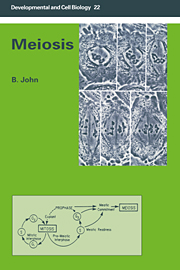Book contents
- Frontmatter
- Contents
- Acknowledgements
- Prologue
- 1 Introduction – multiplication and division
- 2 Modes of meiosis
- 3 Occurrence and timing of meiosis
- 4 Events and mechanisms of meiosis
- 5 Chromosome disjunction
- 6 The genetic control of meiosis
- 7 Sequences and consequences of meiosis
- 8 Evolutionary aspects of meiosis
- Postlogue
- References
- Index
1 - Introduction – multiplication and division
Published online by Cambridge University Press: 21 January 2010
- Frontmatter
- Contents
- Acknowledgements
- Prologue
- 1 Introduction – multiplication and division
- 2 Modes of meiosis
- 3 Occurrence and timing of meiosis
- 4 Events and mechanisms of meiosis
- 5 Chromosome disjunction
- 6 The genetic control of meiosis
- 7 Sequences and consequences of meiosis
- 8 Evolutionary aspects of meiosis
- Postlogue
- References
- Index
Summary
Reproduction of a cell is making two from one. One set of chromosomes makes two sets of chromosomes. Two sets of chromosomes make two nuclei.
Daniel MaziaLIFE CYCLES AND SEXUAL CYCLES
All eukaryotes are constructed out of cells or their products. The simplest forms of life are single cells which are capable of performing all lifeactivities. More complex organisms are composed of collections of cells which individually perform only specific functions. Each eukaryotic cell has a defined and compartmentalized structure in which a specialized,internal and double membrane creates a distinctive environment, thenucleus. Within this organelle the major DNA component of the cell is associated with basic histone proteins to form a molecular complex referred to as chromatin. This chromatin is organized into a series ofsubunits, termed nucleosomes, each of which contains a combination of 200 base pairs (bp) of DNA together with nine histone molecules consisting of two each of H2A, 2B, 3 and 4 plus one HI molecule. The four pairs of histone molecules are bound together as a core which is closely associated with c. 140 bp of DNA, with the remaining 60 bp forming a linker unit to which HI is bound (reviewed in Matthews, 1981).Collectively the nucleosomes are organized around a protein scaffold to form a system of two or more individual threads, the chromosomes, which are highly diffused within the nuclear area.
The nuclear membrane also serves to separate the machinery of RNA transcription, carried out at the chromosome level, from the machinery of RNA translation, carried out at the ribosome level within the cell cytoplasm. Consequently, while the synthesis of proteins is a function of cell cytoplasm, the instructions for this synthesis emanate from the nucleus.
- Type
- Chapter
- Information
- Meiosis , pp. 1 - 28Publisher: Cambridge University PressPrint publication year: 1990



